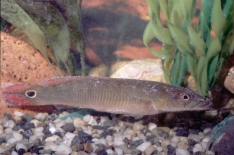| Diseases |
| Diseases |
Is your fish really sick or is it injured?
Too often people mistake an injured fish for a sick fish. A sick fish is one that is suffering from some kind of infection. An injured fish is one that typically has been bitten by another fish. Signs that a cichlid is injured include things like a cloudy eye, missing scales or torn fins. True, there are some infections that can cause these things, but in my opinion, most of the time, when you see those symptoms you will find that they were produced by a fight with another cichlid.
A cloudy eye is a particularly common outcome of a fight. Why? Because when cichlids fight, they aim for the eye. The eye is the most vulnerable part of a cichlid and if one cichlid wants to send a clear message of "GET OUT OF HERE" to another one, it bites the other fish on the eye. Fortunately, cichlid eyes are amazingly resilient and a cloudy eye might heal up in a few days if given the chance (which typically means removing either the injured fish, or the attacking fish). A fish net breeder makes a wonderful penalty box for fish that needs a "time out" for a week or so.
Similarly, missing scales can grow back and fins grow back remarkably quickly when given the chance.
Treating Disease
I am not an expert on cichlid diseases. My philosophy is: do lots of water changes and avoid getting diseases, then you won't have to treat them. There are myriad additives and medicines available in fish stores and I am not qualified to recommend one over the other. Fortunately, many of the more common cichlids are very hardy and seldom get diseases, particularly Central American cichlids.
Most diseases can be traced to dirty water, rotting food or unhealthy feeder fish. The latter is a particular cause for concern because many people are under the impression that large cichlids need to be fed goldfish. This isn't true. Many large cichlids are herbivores (plant-eaters), though they will eat goldfish given the chance. The trouble with goldfish is that they often carry and trasnmit Ich. Ich is a parasite that can be found in goldfish stock tanks in even the finest aquarium shops. It doesn't seem to bother the goldfish nearly as much as it bothers everything else.
A classic scenario (this has happend to me personally on two occasions): you buy some feeder goldfish from a reputable fish store, you feed your pike cichlids and they eat ravenously. Pikes, even little ones, can easily eat 3 or 4 goldfish at a feeding. A couple of days later your pikes look a little droopy and then the next day they are coated with Ich. You quickly treat the water but often the pikes die anyway.
What does Ich look like: Ich looks like a fine dusting of sugar covering all or part of the fish. The first day it may be just a few dozen spots, the next day, there are thousands of spots. It is often most visible on the fins. Ich is not one or two little white bumps on a fish: that is likely something else. This is a picture of a rose-breast cichlid (Astatheros longimanus) with ich.
In some cases, the fish fights the infection by sloughing off lots of mucous in which case you may not see the little white dots, but rather sheets of mucous coming off the fish. Here is a picture of an orange pike cichlid, approximately 6 inches long, with an advanced case of Ich. This fish died the next day. It got Ich from eating feeder goldfish.

What is Ich?: The white sugar-grains are the cysts -- protective cases for the parasite. Medicines cannot harm the cysts. But, sooner or later the cyst opens and out pops the free-living parasite. The free-living organism is vulnerable to medicines.
How to cure Ich: The key to treating Ich is to act quickly, i.e. the minute you see it. If you wait a day or two, the game is often over. To do this, it is generally a good idea to keep a bottle of Ich medicine around the house. There are various brands of Ich medicine, and basically they all require you to treat the tank daily with a number of drops of the liquid medicine. You must treat the tank everyday for the whole period suggested on the bottle. This is often for a week. The treatment works because everyday some of the cysts are hatching, and you can kill that days parasites with the medicine. The life cycle of ich is about a week (faster if the water is warmer) so if you treat for a week, all the cysts will have hatched and the parasites killed. This is also why many people recommend increasing the water temperature.
As the days pass, your fish gets worse and worse and likely won't feed. It becomes a race to see if you can kill the Ich, before the ich kills your fish. As I said at the start, the key is to be prepared and act quickly at the first signs of Ich.
![[Go Back to Contents]](gifs/back.gif) |
![[Send email to Ron Coleman]](gifs/address.gif) |